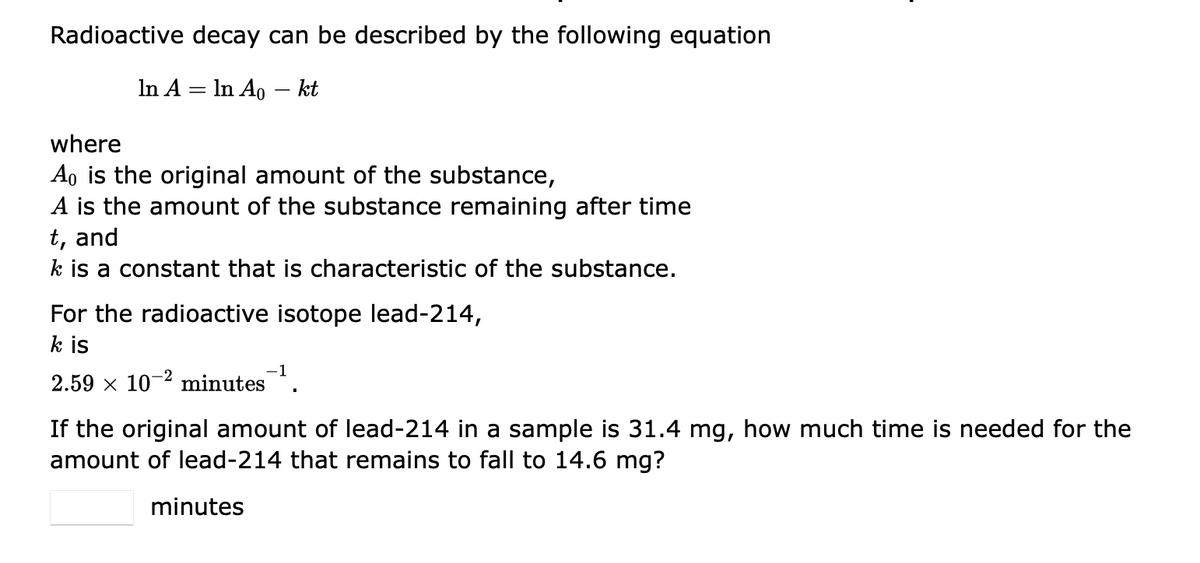Radioactive decay can be described by the following equation In A = In Ao – kt where Ao is the original amount of the substance, A is the amount of the substance remaining after time t, and k is a constant that is characteristic of the substance. For the radioactive isotope lead-214, k is 2.59 x 10-2 minutes. If the original amount of lead-214 in a sample is 31.4 mg, how much time is needed for the amount of lead-214 that remains to fall to 14.6 mg? minutes
Radioactive decay can be described by the following equation In A = In Ao – kt where Ao is the original amount of the substance, A is the amount of the substance remaining after time t, and k is a constant that is characteristic of the substance. For the radioactive isotope lead-214, k is 2.59 x 10-2 minutes. If the original amount of lead-214 in a sample is 31.4 mg, how much time is needed for the amount of lead-214 that remains to fall to 14.6 mg? minutes
Chemistry & Chemical Reactivity
10th Edition
ISBN:9781337399074
Author:John C. Kotz, Paul M. Treichel, John Townsend, David Treichel
Publisher:John C. Kotz, Paul M. Treichel, John Townsend, David Treichel
Chapter25: Nuclear Chemistry
Section25.4: Rates Of Nuclear Decay
Problem 25.5CYU
Related questions
Question

Transcribed Image Text:Radioactive decay can be described by the following equation
In A = In Ao – kt
where
Ao is the original amount of the substance,
A is the amount of the substance remaining after time
t, and
k is a constant that is characteristic of the substance.
For the radioactive isotope lead-214,
k is
2.59 x 10- minutes.
If the original amount of lead-214 in a sample is 31.4 mg, how much time is needed for the
amount of lead-214 that remains to fall to 14.6 mg?
minutes
Expert Solution
Step 1
Given:
- The original amount of lead-214 = 31.4 mg
- The final amount of lead-214 = 14.6 mg
- Rate constant = 2.59×10-2 minutes-1
Trending now
This is a popular solution!
Step by step
Solved in 2 steps

Knowledge Booster
Learn more about
Need a deep-dive on the concept behind this application? Look no further. Learn more about this topic, chemistry and related others by exploring similar questions and additional content below.Recommended textbooks for you

Chemistry & Chemical Reactivity
Chemistry
ISBN:
9781337399074
Author:
John C. Kotz, Paul M. Treichel, John Townsend, David Treichel
Publisher:
Cengage Learning

Chemistry: An Atoms First Approach
Chemistry
ISBN:
9781305079243
Author:
Steven S. Zumdahl, Susan A. Zumdahl
Publisher:
Cengage Learning

Chemistry
Chemistry
ISBN:
9781305957404
Author:
Steven S. Zumdahl, Susan A. Zumdahl, Donald J. DeCoste
Publisher:
Cengage Learning

Chemistry & Chemical Reactivity
Chemistry
ISBN:
9781337399074
Author:
John C. Kotz, Paul M. Treichel, John Townsend, David Treichel
Publisher:
Cengage Learning

Chemistry: An Atoms First Approach
Chemistry
ISBN:
9781305079243
Author:
Steven S. Zumdahl, Susan A. Zumdahl
Publisher:
Cengage Learning

Chemistry
Chemistry
ISBN:
9781305957404
Author:
Steven S. Zumdahl, Susan A. Zumdahl, Donald J. DeCoste
Publisher:
Cengage Learning



Chemistry: The Molecular Science
Chemistry
ISBN:
9781285199047
Author:
John W. Moore, Conrad L. Stanitski
Publisher:
Cengage Learning